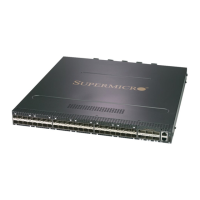Supermicro SSE-F3548S/SSE-F3548SR Configuration User’s Guide
exit
snmp user user1 auth md5 AUTH_PASSWD volatile
snmp user user2 auth sha AUTH_PASSWD priv DES DES_CBC volatile
snmp group superuser user user1 security-model v3 volatile
snmp group generalusers user user2 security-model v3 volatile
snmp access superuser v3 auth read full write full notify full volatile
snmp access generalusers v3 noauth read full notify full volatile
snmp view full 1.3.6.1 included volatile
snmp view restricted 1.3.6.1 included volatile
snmp view restricted 1.3.6.3.10.2.1 excluded volatile
12 RMON
Remote monitoring (RMON) is a method similar to Simple Network Management Protocol (SNMP) and
uses a client-server model to monitor/manageremote devices on the network. RMON and SNMP differ in
the approach used:
• RMON is used for "flow-based" monitoring, while SNMP is often used for "device-based"
management. The data collected in RMON deals mainly with traffic patterns rather than the
status of individual devices as in SNMP.
• RMON is implemented basedon SNMP. RMON sends traps to the management device to notify
the abnormality of the alarm variables by using the SNMP trap mechanism. Traps in RMON and
those in SNMP have different monitored targets, triggering conditions, and report contents.
• RMON provides an efficient means of monitoring subnets. The managed device sends a trap to
the management device automatically once an alarm has reached a certain threshold value.
• Unlike SNMP, the management device need not get the values of MIB variables multiple times for
comparison. Hence the communication traffic between the management device and the managed
device is reduced.
RMON provides statistics and alarm functionality to monitor managed devices.
• The statistics function tracks traffic information on the network segments connecting to its ports.
For e.g. number of oversize packets received.

